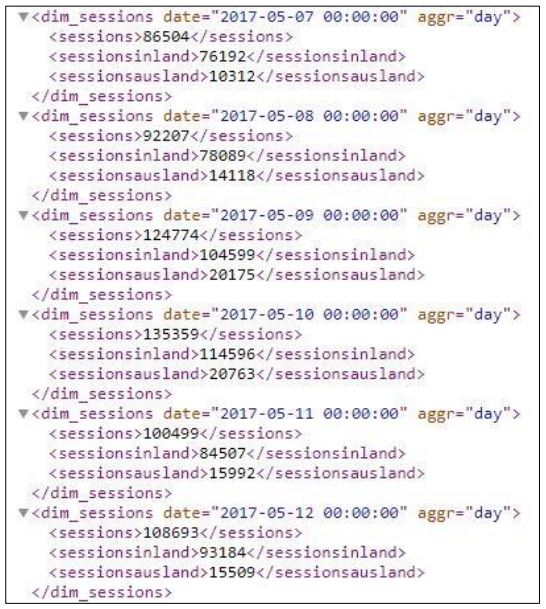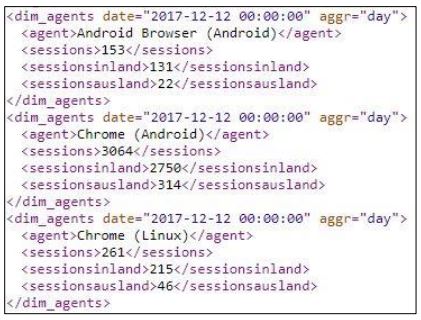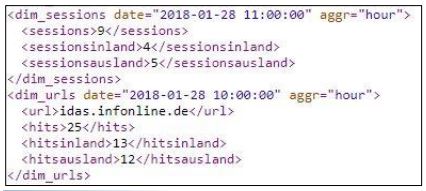Search Knowledge Base by Keyword
-
INFOnline Measurement anonymous
-
- Articles coming soon
-
-
INFOnline Measurement pseudonymous
-
INFOnline Measurement Tools & Tips
-
customer center
XML Download
Service portfolio
Notes
The XML Download service offers you measured values calculated on an hourly or daily basis and time periods aggregated by dates. Smaller time units (e.g. real-time data) are not available
Technical provision
Once you have placed the order for the XML Download service, the service will be enabled for your site in the measuring system. The access is protected by an authentication.
You will get your access data as well as the technical description of the interface along with the confirmation mail of your setup after the INFOnline service team has enabled the service.
Service & Support
Technical support and organisational services by the INFOnline Service & Support Team are included in the XML Download service
Datenverfügbarkeit
- Stundendaten („aggr=hour“) können maximal 3 Tage zurück abgerufen werden.
- Tagesdaten („aggr=day“) können 179 Tage lang abgerufen werden.
- Es können maximal die Daten von 7 Tagen zusammenhängend angefordert werden.
Wenn Daten angefordert werden, die außerhalb dieser Einschränkungen liegen, wird der letzte vorhandene Datensatz ausgegeben.
Limiting and framework conditions
Ordering the service
Please order the XML Download service via the oder center in the INFOnline Customer Center on https://kundencenter.infonline.de/#module/ordercenter .
The further process is as follows:
- INFOnline verifies if there are technical reasons in the measuring system that could hamper the activation of the service for your digital site. Concerning this, the purchaser will be informed.
- INFOnline enables the service for your site
- Then you will get a setup confirmation via email including the access data and the technical description of the interface.
The process described will usually take about three working days. In case of any queries or the like, the INFOnline Service & Support team will contact you in order to clarify them.
Duration and termination
The XML Download service begins with the confirmation of INFOnline that the setup in the measuring system has been successful.
You can terminate the service any time with a notice period of four weeks prior to the end of the quarter. In the event of the termination of the entirely measurement of your digital site, this service expires automatically at the termination date.
Costs
A one-time setup fee of €100 (net, plus the current VAT.) must be paid for the XML Download service for every digital site. There are no running costs.
The invoice takes place after the setup of the service for your site.
Technical Informations

You will receive a setup email with the specific URL as well as the access data that you need for the data retrieval. There will be separate logins with particular passwords for every site.
The measurement data can be found in UTF-8 encoded XML text files without BOM (Byte Order Mark).
Naming structure of XML files
Below you will find an explanation of the naming structures of the possible data aggregations for manual download.
Hourly data
This XML file contains the aggregation data on an hourly basis at the date given.
<Angebotskennung>-hour-<Startzeitpunkt der Aggregation in UTC (Timestamp)>-<Endzeitpunkt der Aggregation in UTC (Timestamp)>
The data on an hourly basis constitute the smallest period under review that is available and are to be considered provisional. Real-time data is not provided.
Daily data
This XML file contains the aggregation data on a daily basis at the date given
<Angebotskennung>-day-<Startzeitpunkt der Aggregation in UTC (Timestamp)>-<Endzeitpunkt der Aggregation in UTC (Timestamp)>
This data is only available after two days, since it is aggregated before it is finally made available. For further restrictions on the availability of measurement data in XML downloads, see chapter 2.4 Data availability.
XML-Download Parameters
The query of the measurement data via the XML download can be adjusted using various parameters. These refer to the aggregation type hour/day and the period in which the data is listed in the XML file. Please refer to chapter 2.4 Data availability for the various restrictions on the output of the data.
The following parameters can be used to supplement the URL “https://xml.ioam.de/xml.php” using the “?” character (for the first parameter) to define the content of the XML file. Each additional parameter must be followed by an “&” character.
- date – date of the request period, alternatively use of {start&end}
- start – start date of the request period, can only be used in conjunction with {end}.
- end – end date of the request period, can only be used in conjunction with {start}
- aggr – aggregation of the request, only hour {hour} or day {day} possible
If individual parameters are not set, the XML file is delivered with default values. For more information, refer to the following description of the parameters.
date-Parameter
The parameter {date} restricts the available measurement data to a specific date. In the following example, an extract of the output of the date parameter is illustrated in addition to the URL.
https://xml.ioam.de/xml.php?date=2017-09-01&aggr=day
This restriction can also be extended to individual hours in the “hour” aggregation.
https://xml.ioam.de/xml.php?date=2017-09-01-15:00&aggr=hour
Sample output can be viewed in chapter 2.6 Example XML download.
start&end-Parameter
The parameters {start} and {end} can only be used in combination and, in contrast to the parameter {date}, limit a time period. The parameters “start&end” can be used both with the aggregation “day” and with the aggregation “hour”. The measurement values requested in this way are subject to the rules for data availability (chapter 2.4 Data availability).
{Start} = start date of the values for the request
{End} = finish date of the values for the request
https://xml.ioam.de/xml.php?start=2017-09-01&end=2017-09-05&aggr=day
The output period can also be extended by specifying a time so that a concrete period can be delivered to the exact hour. However, this restriction can only be used in combination with the data aggregation “hour”.
https://xml.ioam.de/xml.php?start=2017-09-04-12:00&end=2017-09-05-13:00&aggr=hour
Please pay attention to the respective restrictions of data availability in “Chapter 2.4 Data availability”.
Data availability
The data in the XML download can be retrieved dynamically. However, this retrieval is subject to certain availabilities, so that the determined data is available with high performance.
- All data are only available in time format UTC!
- Hourly data: „aggr=hour“
Hourly data will be hold ready for retrieval for three days back at most. In case you require data outside of these limitations, one of the error messages listed below is displayed.
- Daily data : „aggr=day“
Daily data can be retrieved up to 179 days back. The aggregation of the daily data is only possible two days retroactively to the current date (e.g. on 06.10. the daily data from 04.10. is available)!
Error messages
- Error messages for invalid period “…“
If data are not available due to the selection of an invalid period, the following values can occur within the dimension :
- unkown error
- date(XXX) too old
- start(XXX) greater than end(XXX)
- start(XXX) older than max. allowed value (XXX)
- start(XXX) too old
- too much days (XXX/YYY)
- end(XXX) too young
Example output for the error message “start(XXX) greater than end(XXX)“
<error>
start(2017-10-24-10:00) greater than end start(2017-10-06-10:00)
</error>
- Error messages for unavailable data
If data cannot be made available for other reasons, the value “missing data” is output in the XML document in the individual dimensions of the different measured values (2.5.2 Measurement data types in the XML file).
Note
- Hourly data is calculated promptly. Therefore they do not consider the offline use of apps.
- Please note that hourly data are provisional data. In the daily aggregations, the measurement data are fully aggregated. These are the final measurement data.
- Daily data is recalculated with a delay of two days. They contain the figures for the offline use of an app. Up-to-date data is only available on an hourly basis.
- A direct comparison of hourly and daily data is therefore not possible, neither is a simple addition of hourly data to daily data or to data of other temporal aggregation levels.
Description of the XML data
Important!
All times are given in UTC!
Description of the data formats
The requested data in the XML file contains various measurement data and information from a site. This data is output for the specified period and data aggregation. The particular measuring data elements are set up consistently right under the root <szmng>…</szmng> and basically look like this:
<dim_Messdatentyp date="YYYY-MM-DD HH:MM" aggr="day"|"hour"> [<Aggregationskategorie>ABC</Aggregationskategorie>] <Messdatenzahl gesamt>X</Messdaten gesamt> [<Messdatenzahl Inland>Y</Messdaten Inland>] [<Messdatenzahl Ausland>Z</Messdaten Ausland>] </dim_Messdatentyp>
<dim_Messdatentyp>...</dim_messdatentyp>
This element node specifies the data type of the measurement data within this node. The following measurement data types are available:
- Agents
- Clients
- PIs (pro Code)
- Sessions
- URLs
Further information can be found in section 2.5.2 Measurement data types.
The {date} attribute specifies the time of the measurement data given within the node. If the data are requested on an hourly basis, the time is always “00:00:00”.
aggr= „day“ | „hour“
The {aggr} attribute specifies the aggregation of the data within the node. The aggregation depends on the request for the data using the URL and is identical for all measurement data types in the XML file.
<Aggregationskategorie>…</Aggregationskategorie>
This element is only available for measurement data types that are aggregated via another category in addition to a number (for example, “PIs per code”). The category name is individual depending on the aggregation characteristic (example: <code> … </code>).
[<Messdatenzahl>…</Messdatenanzahl>]
The number of measured data is given in the form of three values: The total value for the node as well as individual values for “Inland” and “Abroad”. The name of the sub-element is based on the measurement data type. The following example is obtained for the sessions of one day:
<sessions>63526</sessions> (Gesamtzahl) <sessionsinland>53061</sessionsinland> <sessionsausland>10465</sessionsausland>
Measurement data types in the XML file
The requested XML file always contains the identical measurement data types. If there are no values for the selected aggregation period, these nodes are listed without values. Exampel (no errors):
<dim_errors/>
Im folgenden werden die verfügbaren Messdatentypen genauer beschrieben.
Important!
All times are given in UTC!
Note
- A hit is a registered request from the measuring system to the SZMnG measuring pixel in stationary or mobile websites or apps.
- PI (“Page Impression”) is a hit that, according to IVW guidelines, is to be classified as PIrelevant.
- Action is a hit that is registered in an app by the measurement system after a supporting event has been triggered. Actions can be, but do not have to be PI-relevant.
- Measurement data elements for aggregation via error code types do not contain subelements with partial information on access from inland and abroad (see below).
Agents – Number of Visits per browser type
This measurement data type displays the number of visits per dedicated browser type in the selected aggregation period.
Example:
<dim_agents date="2017-09-20 00:00:00" aggr="day"> <agent>Chrome (Android)</agent> <sessions>2348</sessions> <sessionsinland>2005</sessionsinland> <sessionsausland>343</sessionsausland> </dim_agents>
Reference:
For every browser type, a separate node is created for each requested time period.
Possible aggregation:
Hourly and daily values
Error – Hits per error code
This measurement data type contains the hits that occur in the aggregation period for a dedicated error code type. A large part of the hits listed here are not PI-relevant and can only be requested for hourly data.
Example:
<dim_errors date="2017-09-20 19:00" aggr="hour"> <error>A1</error> <hits>1</hits> <dim_errors>
Reference
For each error code, a node is created for the requested aggregation period.
Possible aggregation:
Hourly values only
Events – Actions per event type
This measurement data type gives the number of actions in the aggregation period that occur on a dedicated event type. The measurement data type is only filled for apps. Some of the counted actions are not PI-relevant. For Web and MEW offers, this is always empty.
Example:
<dim_events date="2017-09-12 00:00:00"aggr="day">
<event>application-enterforeground</event>
<hits>42</hits>
<hitsinland>40</hitsinland>
<hitsausland>2</hitsausland>
</dim_events>
Reference:
A separate node for each aggregation period is listed for each event type with counted actions.
Possible aggregation:
Hourly and daily values
PIs – PIs per code
This measurement data type provides the PIs for the requested aggregation period per dedicated code.
Example:
<dim_pis date="2017-09-20 00:00:00" aggr="day">
<code>code123456</code>
<pis>35</pis>
<pisinland>29</pisinland>
<pisausland>6</pisausland>
</dim_pis>
Reference:
A separate node is created for each code per time period.
Possible aggregation:
Hourly and daily values
Clients – Number of clients
This measurement data type displays the number of identified clients for the requested aggregation period.
Example:
<dim_sessions date="2017-09-20 00:00:00" aggr="day">
<sessions>63526</sessions>
<sessionsinland>53061</sessionsinland>
<sessionsausland>10465</sessionsausland>
</dim_sessions>
Reference:
For the specified time period, one node is created per time unit (day or hour) to output the clients.
Possible aggregation:
Hourly and daily values
URLs – Anzahl Hits pro URL
Dieser Messdatentyp gibt die Anzahl der PIs pro URL aus, auf die im Aggregationszeitraum Traffic eingegangen sind. Die gezählten Hits sind PI-relevant und können als vollwertige PIs betrachtet werden.
Beispiel:
<dim_urls date="2016-04-12 00:00:00" aggr="hour">
<url>www.infonline.de</url>
<hits>21</hits>
<hitsinland>20</hitsinland>
<hitsausland>1</hitsausland>
</dim_urls>
Bezug:
Pro im Aggregationszeitrum besuchter URL wird ein separater Knotenpunkt pro Zeitintervall erstellt.
Mögliche Aggregation:
Stunden und Tageswerte
Errorcodes
Die folgende Tabelle beschreibt die Errorcodes, die im Messdatenelement „Anzahl Hits pro Errorcode-Typ“ auftreten können:
Status-/ Error-Code | Bedeutung |
OK | No Error (Wenn kein Error (Ex) aufgetreten ist, Notifications (Nx) sind möglich) |
N1 | Keine UUID in ae oder mi gefunden |
N3 | UUID gefunden, ie gesetzt (App-Messung) |
N4 | Kein i00-Cookie gesetzt |
N5 | Cookie aufgrund niedrigerer Versionsnummer erneuert |
N6 | Mi gefunden, ie gesetzt (Hybrid-Messung) |
N7 | Is gefunden, ie gesetzt (iPhone-Hack) |
N8 | Keine id gefunden, benutze hash |
N9 | Keine id gefunden, benutze Hash und JavaScript-Fingerprint |
N10 | Kein Zugriff auf LSO möglich |
N11 | aid.io fehlerhaft |
N12 | Markierung für IPv6 (Vorbereitung aif IPv6) |
N13 | Codetyp fehlte im Aufruf, es wird dann auf CP gesetzt und der Standard-Leercode gesetzt (JS-Funktionalität) |
N14 | Cookie defekt, wurde neu gesetzt |
A1 | Referrer nicht in Whitelist (Datensatz in Filtered-DWH schreiben) |
A2 | Fehler bei Clientresolving (Datensatz in Filtered-DWH schreiben) |
A3 | Session konnte nicht aufgelöst werden |
A4 | Prüfsumme im Datensatz stimmt nicht |
A6 | NoScript wurde genutzt, war aber nicht aktiviert Clientresolving (Datensatz in Filtered-DWH schreiben) |
A7 | Aufruf einer App wurde aufgrund einer IVW-Korrektur gefiltert |
Status-/Error-Code | Bedeutung |
A8 | Aufruf einer MEW innerhalb einer App (hybrid) wurde aufgrund einer IVW-Korrektur gefiltert |
A9 | Aufruf einer MEW wurde aufgrund einer IVW-Korrektur gefiltert |
A10 | Device liefert via Library Daten aus der Zukunft |
A11 | JSON in Datensatz (ae oder mi) konnte nicht verarbeitet werden. Defektes JSON-Objekt |
A12 | Flash-Pixel (fp) |
A13 | Newsletter-Pixel (np) |
A14 | Test-Pixel |
|
|
Beispiel XML-Download
Beispiel (Zeitraum):
URL: https://xml.ioam.de/xml.php?start=2017-05-07&end=2017-05-12&aggr=day
Ausschnitt aus der XML-Datei:

Beispiel (Date mit Tagesdaten):
URL: https://xml.ioam.de/xml.php?date=2017-12-12&aggr=day
Ausschnitt aus der XML-Datei:

Beispiel (Aggregation hour mit Uhrzeit):
URL: https://xml.ioam.de/xml.php?date=2017-12-12&aggr=day
Ausschnitt aus der XML-Datei:



